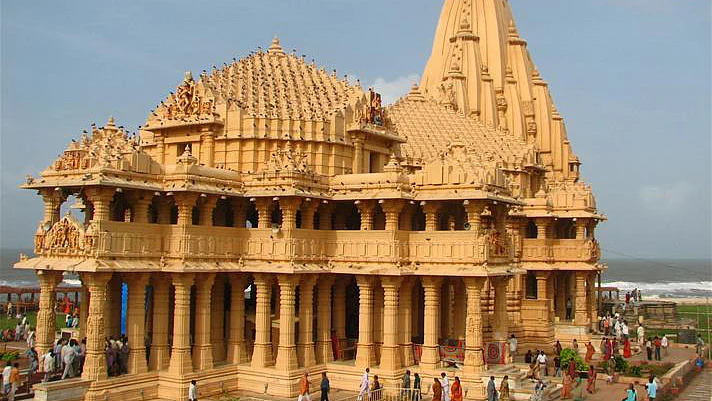(A controversy erupted on 29 November 2017 over reports that Congress Vice President Rahul Gandhi’s name had been entered in the non-Hindu visitor list of the Somnath temple. The following article was first published on 4 April 2015 and has been updated and reposted from The Quint’s archives in light of the row over the Somnath temple register.)
Historically among the oldest, considered to be among the holiest, the Somnath Temple in Junagadh district now finds itself in the centre of discussion about religious freedom.
This after the Shree Somnath Trust (SST) put up three public notices on the main entrance asking non-Hindus to seek permission before entering the temple premises.
Shree Somnath Jyotirling is a religious place of Hindus. Non-Hindus will be allowed entry for darshan in this pious religious place of worship only after they contact the office of the general manager and get his due permission, as Indian Express had reported.
Why Now?
In a phone interview to The Quint, Vijaysinh Chavda, the Deputy Manager of the Somnath Temple Trust says entry into the temple has been restricted only for security purposes.
We want to avoid any argument or unpleasantness between visitors and the security guards. The notice has been put up keeping that in mind.Vijayinsh Chavda, Deputy Manager, Somnath Temple Trust
But was there an argument that necessitated the notice? And just what kind of unpleasantness are they hoping to avoid with this restriction?
No argument has taken place here. But for example, a non-Hindu wants to come into the temple. This is a temple, not a tourist place, this is a place for darshan, for worship. We allow entry only to those who want to offer prayers.
The Somnath Temple is considered a place of pride for Hindus and was plundered several times by foreign invaders like Mohammad Ghazni. The raids have been construed by historians as having left a deep gash on the psyche of the original inhabitants. In fact, Sardar Vallabhai Patel and Rajendra Prasad are known to have played a lead role in rebuilding the temple after Independence.
The Trust is chaired by former Gujarat Chief Minister Keshubhai Patel and its board of trustees includes Prime Minister Modi, veteran BJP leader LK Advani and retired Chief Secretary of Gujarat Pravin Laheri.
How Do Non-Hindus Get In?
Non-Hindus will have to visit the General Manager’s office which is within the Somnath Temple premises. They will need to volunteer basic details, such as their names and purpose of visit before being allowed inside.
Unfair to Single Out Somnath Temple
Many famous Hindu temples across India regulate or restrict entry in some way or the other.
1. Sabrimala Temple
Women between the age of 10-50 years are not allowed inside the sanctum sanctorum of this ancient temple in Kerala and the matter is pending before a constitutional bench of the Supreme Court. Reason for this is that Lord Ayyappa is considered to be a bachelor God, a brahmachari who would be considered to be defiled if a woman who is able to reproduce or a woman who menstruates touches the God. Men from all religions and castes however, are welcome.
2. Jagannath Temple
Non-Hindus are not allowed inside this 12the century temple. Till 2006, the entry of Dalits into the temple was a grey area. A High Court order eased entry norms and when four Dalits and a woman walked into the temple unopposed, it hit the headlines. But in August 2012, a board was reportedly hung outside the Puri Temple stating “only Orthodox Hindus allowed” after an American national was seen at the Rath Yatra.
3. Guruvayurappan Temple
While there are no hard and fast rules about who can enter this temple dedicated to Lord Krishna, there is a strict dress code. Men have to wear a veshti with a thundu (towel) and women are ideally advised to wear traditional sarees, but salwar suits and churidhaars are not entirely banned either.
While entry into mosques is regulated for women, men from all religions are allowed inside the sanctum sanctorum. According to Islamic scripture, women are not allowed near graves. Ajmer Sharif however, is an exception where women from all faith can pray at the grave of Moinuddin Chisti. Gurudwaras also allow men and women from all faiths as long as they cover their heads.
Place of Worship Or Historical Monument?
Apart from places of worship, India’s ancient temples are also of archaeological and historical importance. The spokesperson for the Sabrimala Temple Rahul Eswar argues that if the spiritual sanctity of temples had not been respected, these places of worship would not have survived for hundreds of years.
The fact that spiritual significance is given paramount importance in our country, is also evident from the Indian judiciary’s reluctance to interfere in matters concerning the administration of temples.
Is Somnath Temple the only temple that restricts entry of non-Hindus? Certainly not. But could the public notice have been more sensitively worded at a time the communal debate is easily stirred? Perhaps yes.
(At The Quint, we question everything. Play an active role in shaping our journalism by becoming a member today.)
